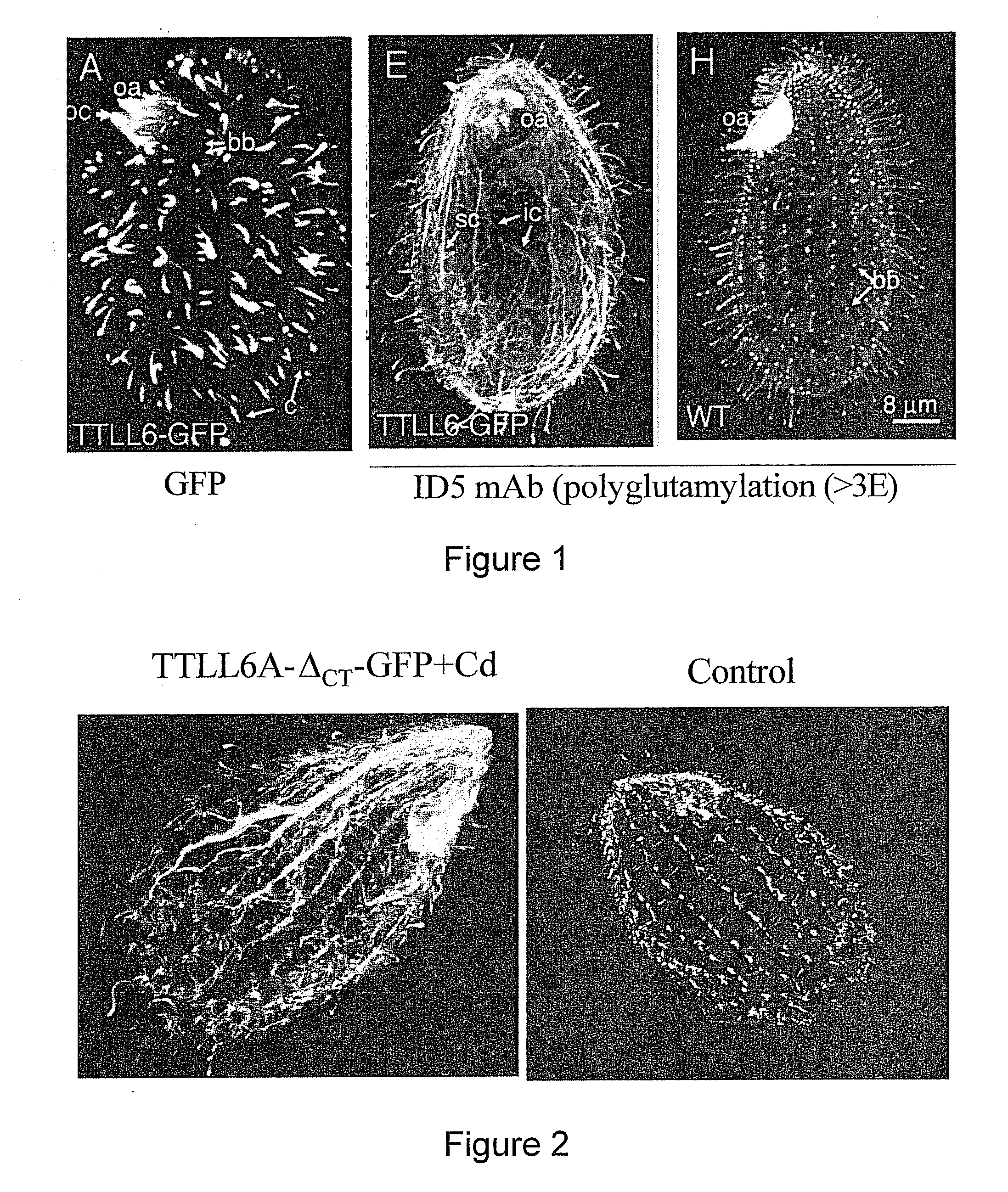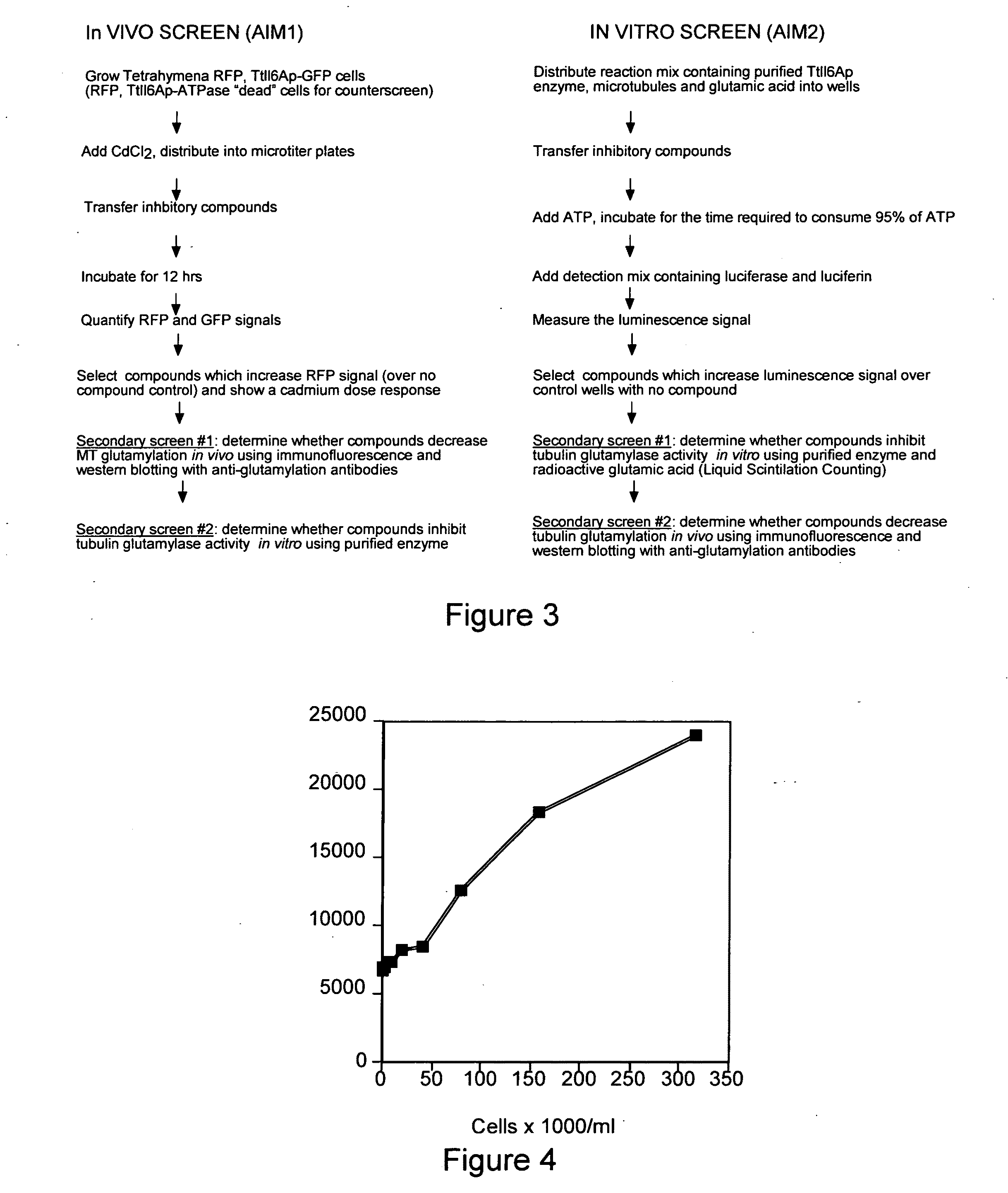Biological system and assay for identifying modulators of tubulin ligases
a tubulin ligase and assay technology, applied in the field of biological system and assay for identifying tubulin ligase modulators, can solve the problems of difficult development of tubulin primary polypeptide inhibitors, and large limitation of widely used microtubule-targeting compounds (such as vinblastine or paclitaxel), so as to reduce polyglutamylation and shorten glutamyl sid
- Summary
- Abstract
- Description
- Claims
- Application Information
AI Technical Summary
Benefits of technology
Problems solved by technology
Method used
Image
Examples
examples
[0128]The present invention is illustrated by the following examples. It is to be understood that the particular examples, materials, amounts, and procedures are to be interpreted broadly in accordance with the scope and spirit of the invention as set forth herein.
example i
Tubulin Glutamylase Enzymes are Members of the TTL Domain Protein Family
Summary
[0129]Glutamylation of tubulin has been implicated in several functions of microtubules but the identification of the responsible enzyme(s) has been challenging. We show here that the neuronal glutamylase is a protein complex containing a tubulin tyrosine ligase-like (TTLL) protein, TTLL1. TTLL1 is a member of a large family of proteins with a TTL domain, whose members could catalyze ligations of diverse amino acids to tubulins or other substrates. In the model protist Tetrahymena thermophila two conserved types of glutamylases were characterized, which differ in substrate preference and subcellular localization. Janke et al. (2005) Science 308, 1758-1762.
Introduction
[0130]Polyglutamylation is an uncommon type of posttranslational modification that adds multiple glutamic acids to a γ-carboxyl group of a glutamate residue of target proteins, including tubulin and nucleosome assembly proteins NAP1 and NAP2 ...
example ii
Biological Assay for Glutamylase Inhibition
[0171]The invention provides a phenotype-based assay for inhibitors of tubulin glutamylation. The assay is a biological assay; that is, it is performed in a host cell, preferably Tetrahymena. It is also referred to herein as an “in vivo” assay or “Assay I.”
[0172]Overproduction of the truncated Ttll6Ap-GFP under cadmium-inducible promoter (at 2.5 μg / ml CdCl2) caused a tight arrest in cell multiplication of Tetrahymena. Decreasing the concentration of cadmium allowed for more growth while increasing it two-fold was lethal within 18 hours. Thus, the extent of growth inhibition by Ttll6Ap is dependent on its intracellular concentration (which in turn is dependent on cadmium concentration). The presence of a compound which inhibits Ttll6Ap activity should partly or completely rescue the cell growth arrest. A preferred embodiment of the in vivo assay is outlined in FIG. 3 (left panel). The assay involves adding CdCl2 to Tetrahymena cells in which...
PUM
| Property | Measurement | Unit |
|---|---|---|
| temperature | aaaaa | aaaaa |
| pH | aaaaa | aaaaa |
| pH | aaaaa | aaaaa |
Abstract
Description
Claims
Application Information
 Login to View More
Login to View More - R&D
- Intellectual Property
- Life Sciences
- Materials
- Tech Scout
- Unparalleled Data Quality
- Higher Quality Content
- 60% Fewer Hallucinations
Browse by: Latest US Patents, China's latest patents, Technical Efficacy Thesaurus, Application Domain, Technology Topic, Popular Technical Reports.
© 2025 PatSnap. All rights reserved.Legal|Privacy policy|Modern Slavery Act Transparency Statement|Sitemap|About US| Contact US: help@patsnap.com



